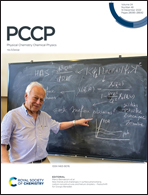High excellent hydrogen evolution characteristics and novel mechanism of two-dimensional tetra-phase OsN2 and ReN2†
Abstract
It is essential to find a kind of electrocatalyst for hydrogen evolution reduction (HER) comparable with a noble metal that has good conductivity and abundant active sites. Based on systematic searches by first-principles calculations, we discovered two-dimensional transition-metal nitrides, tetra-phase OsN2 and ReN2 monolayers, as potential HER electrocatalysts with superior thermodynamic and kinetic stability. They exhibited excellent catalytic activity due to the presence of multiple active sites with a density of 8 × 1015 site per cm2 and an overpotential close to 0. In addition, we also found that the synergistic effect of strain and coverage makes them have a good hydrogen evolution activity. The ΔGH of the OsN2 monolayer at 1% tensile strain under 3/4 hydrogen coverage is 0.02 eV, and that of ReN2 at 1/2 hydrogen coverage could decrease to 0.001 eV. Different from other common transition metal nitrides, we found that the active sites of OsN2 and ReN2 monolayers are both at nitrogen atoms, which could be further understood by the crystal orbital Hamiltonian population analysis between N and metal atoms. All these interesting findings not only provide new excellent candidates but also provide new insights into the mechanism of hydrogen evolution of nitrides.



 Please wait while we load your content...
Please wait while we load your content...